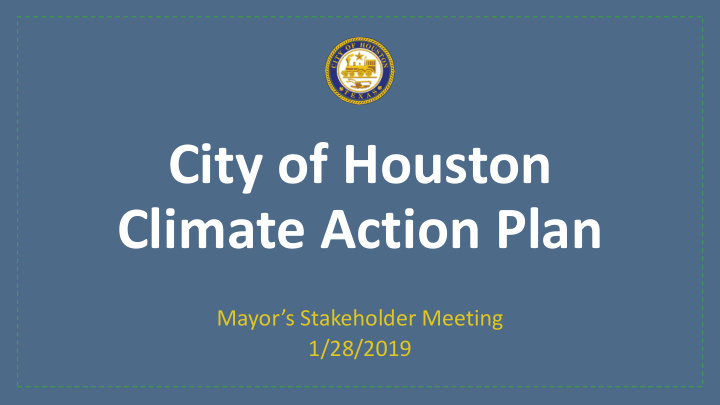



City of Houston Climate Action Plan Mayor’s Stakeholder Meeting 1/28/2019
Why Cities are taking Climate Action Hurricane Harvey Source: World Bank Group
Houston’s Commitment to Climate Action June 1, 2017: The U.S withdraws from the 2015 Paris Agreement June 24, 2017: Mayor Turner, co-chair of Climate Mayors, commits to adopt Paris Agreement goals in Houston
Houston Community Greenhouse Gas Emissions
Stakeholder Survey Results
Community Stakeholder Priorities 17. 10% 45. 27% 21. 12% 28. 17% 29. 17% 28. 17% Transportation Public Outreach Decarbonization Building Optimization Equity Pollution/Solid Waste N = 93 Respondents from Stakeholder Survey
Stakeholder Ranking of Most Significant Measures Increased amount clean energy resources Community emission reductions Emission Reduction per Person Reduced Vehicle Miles Traveled (VMT) Increased number transit options Reduce Water Use Reduced Waste Increased green jobs Increased Affordable Housing More Local Food 0 1 2 3 4 5 6 7 8 N = 93 Respondents from Stakeholder Survey
Stakeholder Ranking of Effectiveness of Measures Policy (city/state levels) Financial assistance Increase Fuel Switching Incentives/technical assistance Public Information/awareness 0 0.5 1 1.5 2 2.5 3 3.5 4 N = 93 Respondents from Stakeholder Survey
Climate Action Plan
What is a Climate Action Plan (CAP)? • A climate action plan should address the need to reduce greenhouse gas emissions, adapt to the impacts of climate change and deliver wider social, environmental, and economic benefits. • Objectives of plan are to: Decrease traffic congestion Improve air quality Provide better access to green space Improve quality of life Reduce energy costs through energy efficiency and renewable energy Increase resilience
Goals of the CAP • Goal: Lay the foundation for actions that will make the City carbon-neutral by 2050. Example: New York City
Leading by Example • Renewable Energy: • The City is the largest municipal purchaser of renewable energy for city operations, receiving 92% of its power from renewable energy • Building Optimization : • Since 2004, the City has required all new buildings to be LEED Certified; currently have 37 LEED buildings • Since 2007, the City has invested $70 million in energy efficiency retrofits: 6 million square feet; achieving greenhouse gas emission reductions of 35% • Converted ~175,000 streetlights to LED technology; reducing the City’s streetlight energy usage by ~50%. • Transportation • 6.3% of the City’s fleet is hybrid. • Working to develop ambitious fleet electrification goals.
Climate Action Plan Structure and Process
Planning Organizational Structure Mayor Mayor’s Advisory Task Force HARC ARA/Office of COH Departments C40 Sustainability Communications Partner Decarbonization Building Optimization Transportation Waste and Pollution Work Group Work Group Work Group Work Group SME SME SME SME Community/Equity Community/Equity Community/Equity Community/Equity
Climate Action Plan Technical Approach
Process for Plan Development Technical Assistance:
Using Scenario Planning to Drive Policy 2 Data is analyzed by sector to better 1 understand city- wide footprint Data measurement is completed on current emissions 5 3 Data is input into City and Community take CURB tool to drive measures to support science- scenario planning and based targets Outputs & recommendations 4 action steps are summarized in policy brief 18
Overview of CURB Model • The CURB tool is an integrated model that measures GHG emissions among 6 different sectors Municipal Private Building Electricity Water & Buildings & Solid Waste Transportation Energy Generation Wastewater Lighting Model is data-driven and city-specific with 500+ data fields to complete CURB uses population growth, GDP growth or International Energy Agency’s methodology to estimate future emissions 100+ cities have adopted the CURB model, allowing for comparability and benchmarking
Timeline
Thank you! Questions? Contact Information: Lara Cottingham Chief Sustainability Officer Lara.Cottingham@houstontx.gov 832-393-8503 Learn more: http:/bit.ly/Houston-CAP
Recommend
More recommend